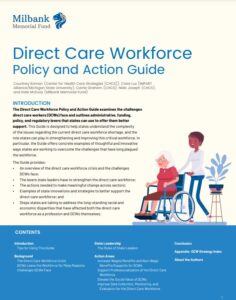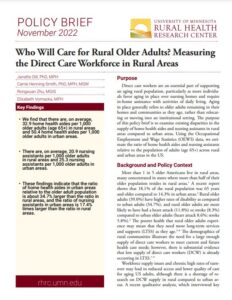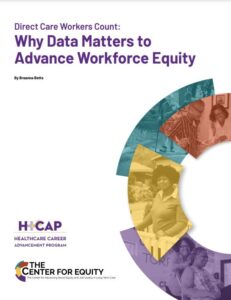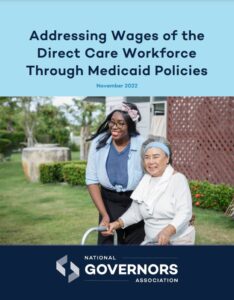5 Recent Must-Reads on the Direct Care Workforce

Reflecting growing recognition of the essential role of the direct care workforce, numerous studies and reports have been published by researchers, advocates, state leaders, and other experts on this workforce in the past few years. We recently updated PHI’s National Direct Care Workforce Resource Center—the nation’s premier online library for information on the direct care workforce—to include the newest key publications from the field. Below are five highlighted reports from a range of experts that convey the current challenges facing the direct care workforce and offer opportunities for change.
Direct Care Workforce Policy and Action Guide
 The Direct Care Workforce Policy and Action Guide collaboratively written by the Center for Health Care Strategies, Milbank Memorial Fund, and Michigan State University, provides detailed recommendations for policy action to address the many challenges facing the direct care workforce. The authors—including Clare Luz, PHI’s partner in the Essential Jobs, Essential CareTM initiative—highlight specific state policy examples, such as collective bargaining efforts in Connecticut and Washington state that have resulted in increased wages and improved benefits for direct care workers. This report provides tangible examples of policy levers that states can implement to improve direct care job quality and attract new workers to the field.
The Direct Care Workforce Policy and Action Guide collaboratively written by the Center for Health Care Strategies, Milbank Memorial Fund, and Michigan State University, provides detailed recommendations for policy action to address the many challenges facing the direct care workforce. The authors—including Clare Luz, PHI’s partner in the Essential Jobs, Essential CareTM initiative—highlight specific state policy examples, such as collective bargaining efforts in Connecticut and Washington state that have resulted in increased wages and improved benefits for direct care workers. This report provides tangible examples of policy levers that states can implement to improve direct care job quality and attract new workers to the field.
Who Will Care for Rural Older Adults? Measuring the Direct Care Workforce in Rural Areas
 This policy brief by sociologist Janette Dill and colleagues at the University of Minnesota Rural Health Research Center addresses the persistent question of how to assess supply and demand for direct care workers. Using data from the Bureau of Labor Statistics (BLS) and Health Resources and Services Administration (HRSA), the authors estimate the size and density of the direct care workforce relative to the population of older adults in rural versus urban areas—and find that there are fewer direct care workers per 1,000 older adults in rural areas across the country. For example, there are approximately 50 home health aides for every 1,000 older adults in urban areas compared to only 33 home health aides per 1,000 older adults in rural areas. The brief concludes by discussing the importance of building better long-term care infrastructure in rural areas, with specific examples from states that are leading the way.
This policy brief by sociologist Janette Dill and colleagues at the University of Minnesota Rural Health Research Center addresses the persistent question of how to assess supply and demand for direct care workers. Using data from the Bureau of Labor Statistics (BLS) and Health Resources and Services Administration (HRSA), the authors estimate the size and density of the direct care workforce relative to the population of older adults in rural versus urban areas—and find that there are fewer direct care workers per 1,000 older adults in rural areas across the country. For example, there are approximately 50 home health aides for every 1,000 older adults in urban areas compared to only 33 home health aides per 1,000 older adults in rural areas. The brief concludes by discussing the importance of building better long-term care infrastructure in rural areas, with specific examples from states that are leading the way.
RAISE Act State Policy Roadmap for Family Caregivers: The Direct Care Workforce
 The RAISE Family Caregivers Act, which was signed into law in January 2018, directed the Department of Health and Human Services to develop and publish a National Family Caregiving Strategy. A key component of the resulting strategy is bolstering the direct care workforce. To assist states in this effort, the National Academy of State Health Policy (NASHP) published a comprehensive report in March 2022 titled RAISE Act State Policy Roadmap for Family Caregivers: The Direct Care Workforce. As one example, the report describes how states can strengthen their workforce pipelines, as Michigan has done by increasing the accessibility of CNA training programs for individuals with disabilities. The report emphasizes the urgency of addressing the workforce crisis, particularly in the wake of the COVID-19 pandemic.
The RAISE Family Caregivers Act, which was signed into law in January 2018, directed the Department of Health and Human Services to develop and publish a National Family Caregiving Strategy. A key component of the resulting strategy is bolstering the direct care workforce. To assist states in this effort, the National Academy of State Health Policy (NASHP) published a comprehensive report in March 2022 titled RAISE Act State Policy Roadmap for Family Caregivers: The Direct Care Workforce. As one example, the report describes how states can strengthen their workforce pipelines, as Michigan has done by increasing the accessibility of CNA training programs for individuals with disabilities. The report emphasizes the urgency of addressing the workforce crisis, particularly in the wake of the COVID-19 pandemic.
Direct Care Workers Count: Why Data Matters to Advance Workforce Equity
 This 2022 report from the Center for Advancing Racial Equity and Job Quality in Long-Term Care discusses how and why to improve data collection on and with the direct care workforce. The lack of consistent data collection and robust, disaggregated data on this predominantly women of color workforce hampers efforts to address workforce challenges and improve care quality. Conversely, the report emphasizes that, with better data, state and federal leaders can “maximize the impact of public funding, ensure public dollars are spent on good quality, family-sustaining jobs, and support states in course-correcting on the racist, sexist legacy of care work in America.”
This 2022 report from the Center for Advancing Racial Equity and Job Quality in Long-Term Care discusses how and why to improve data collection on and with the direct care workforce. The lack of consistent data collection and robust, disaggregated data on this predominantly women of color workforce hampers efforts to address workforce challenges and improve care quality. Conversely, the report emphasizes that, with better data, state and federal leaders can “maximize the impact of public funding, ensure public dollars are spent on good quality, family-sustaining jobs, and support states in course-correcting on the racist, sexist legacy of care work in America.”
Addressing Wages of the Direct Care Workforce Through Medicaid Policies
 This recent report from the National Governors Association highlights a range of implemented strategies to raise direct care worker compensation across 19 states. These strategies include wage pass-through and wage floor policies, among others. For example, New Jersey mandated that direct care workers receive at least $3 more per hour than the minimum wage by 2024. The report emphasizes the importance of reporting, auditing, and enforcement provisions to ensure that designated funding actually reaches workers’ wages. By presenting a wide array of policy mechanisms, the report acknowledges that there is no one-size-fits-all approach, given different states’ priorities, market conditions, and administrative structures.
This recent report from the National Governors Association highlights a range of implemented strategies to raise direct care worker compensation across 19 states. These strategies include wage pass-through and wage floor policies, among others. For example, New Jersey mandated that direct care workers receive at least $3 more per hour than the minimum wage by 2024. The report emphasizes the importance of reporting, auditing, and enforcement provisions to ensure that designated funding actually reaches workers’ wages. By presenting a wide array of policy mechanisms, the report acknowledges that there is no one-size-fits-all approach, given different states’ priorities, market conditions, and administrative structures.
In addition to these highlighted recent reports, PHI’s National Direct Care Workforce Resource Center includes a searchable database of academic and applied research publications and policy resources. PHI also tracks state policy developments, conducts original research on the direct care workforce, and issues studies, reports, and multimedia resources.






